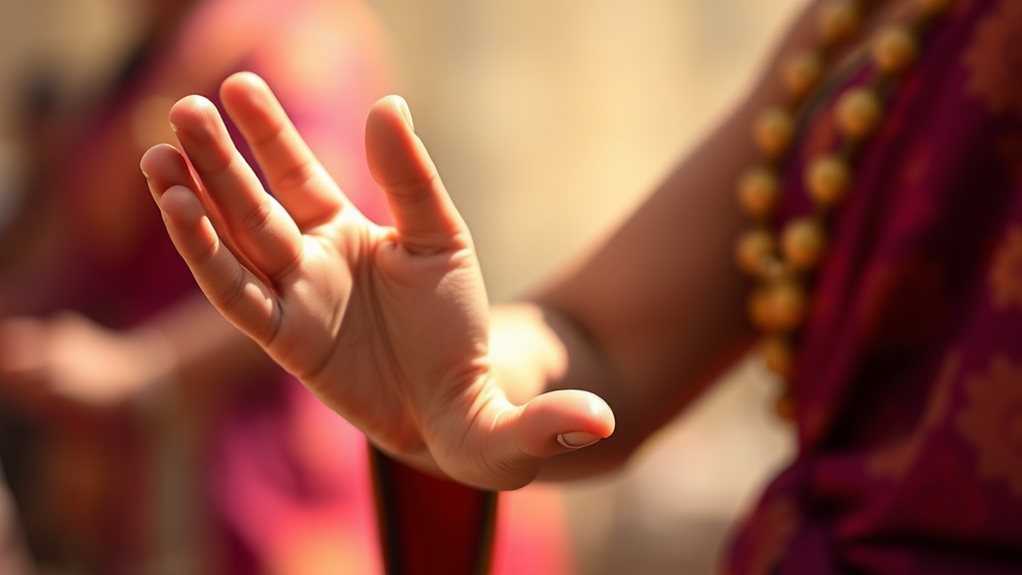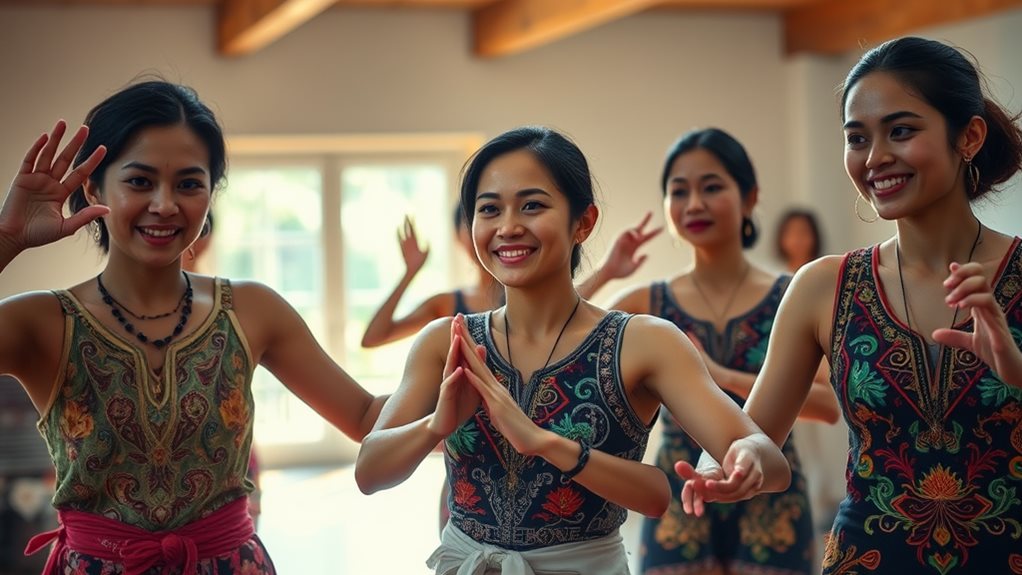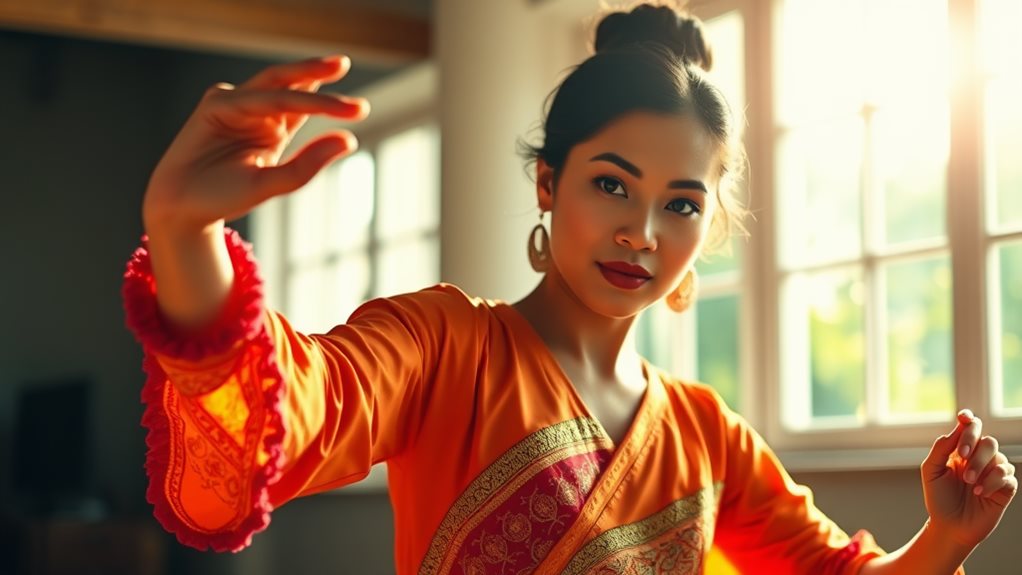Traditional Filipino Dance as a Form of Healing****
Traditional Filipino dance offers a unique approach to healing, combining indigenous and Spanish influences. Filipino dance incorporates physical movement, emotional expression, and communication, promoting overall well-being. Two notable examples of traditional Filipino dances used in dance therapy are the Tinikling and Singkil.
The Tinikling Dance
The Tinikling dance involves intricate footwork and hand movements, mimicking the steps of a bird. This dance improves coordination, balance, and physical health. By mastering the Tinikling dance, individuals can develop better motor skills and cognitive function.
The Singkil Dance
The Singkil dance is a traditional Filipino dance that tells the story of a princess and her journey through a forest. This dance promotes emotional expression and communication, allowing individuals to convey their feelings through movement. By participating in the Singkil dance, individuals can improve their emotional intelligence and develop stronger relationships with others.
Benefits of Dance Therapy
Dance therapy using traditional Filipino dances offers several benefits, including stress reduction, self-discovery, and community building****. By connecting with their cultural heritage, individuals can develop a stronger sense of identity and belonging.
Integration with Modern Healthcare****
The integration of traditional Filipino dance therapy within modern healthcare reveals a promising approach to wellness. By incorporating dance therapy into treatment plans, healthcare professionals can provide a more holistic approach to patient care. This ancient wisdom offers a path to wellness, and its integration within modern healthcare can lead to better patient outcomes.
Traditional Filipino Dance Moves

Three key aspects define traditional Filipino dance moves: historical context, choreography and steps, and props and costumes**. These dance styles originated during the Spanish colonial era**, blending indigenous traditions with Spanish influences.
Regional variations exist, reflecting the diverse cultures of Luzon, Visayas, and Mindanao. For example, the Singkil dance showcases pre-colonial heritage with its tribal roots.
Diverse choreography and steps are hallmarks of traditional Filipino dances. The Tinikling dance requires precise footwork and coordination, with challenging rhythmic patterns.
In contrast, the Sakuting dance involves the use of sticks, creating a unique visual and rhythmic experience. Additionally, dances like Pangalay mimic nature with intricate hand and foot movements, showcasing fluidity and precision.
Props and costumes play a vital role in traditional Filipino dance performances. Objects like bamboo poles, sticks, oil lamps, and the malong are used to create a rich visual landscape.
The malong, in particular, is versatile and is used in various ways within certain dance styles. Fans and scarves add to the expressive potential of the dance, enhancing the storytelling and emotional impact of each performance.
Popular Filipino Folk Dances
Filipino Folk Dances Offer a Glimpse into the Country's Rich History and Diverse Traditions****
Filipino folk dances are a vibrant tapestry of cultural expression. They offer a captivating glimpse into the archipelago's rich history and diverse traditions. Filipino folk dances can be broadly categorized into three main regions: Luzon, Visayas, and Mindanao.
In Luzon, dances like the Pandanggo sa Ilaw, where performers balance lamps while moving to the music, showcase grace and skill. The Binasuan, with its wine-filled glasses, tests balance and coordination, often performed in dance competitions. Maglalatik's mock war, using coconut shells, creates incredible rhythms. The elegant Rigodon, with its complex patterns, is perfect for formal events.
In the Visayas region, you'll discover the playful Itik-Itik, mimicking a duck's movements, often seen at folk dance festivals. Tinikling, the national dance, challenges performers with its bamboo poles. The courtship dance Kuratsa unfolds in three stages, culminating in a happy ending. Pantomina, the "Dance of the Doves," playfully portrays bird courtship.
Mindanao boasts its unique dances. Singkil's intricate footwork avoids clashing bamboo poles, narrating an epic tale. Kappa Malong-Malong showcases the versatility of the malong garment. The Pangalay, with its fluid arm movements, reflects the grace of nature, often featured in social gatherings.
Regional Folk Dance Festivals and Competitions
These dances can be witnessed in many regional folk dance festivals and dance competitions across the country. Each festival offers a unique cultural experience, allowing you to explore and celebrate the stories and movements behind these traditional dances.
Cultural Significance and Origins

Filipino Dance Therapy Origins
Filipino dance therapy has its roots in the nation's rich shamanic traditions. Pre-colonial shamanic practices, led by female shamans known as *babaylan* and *balian*, played a crucial role in community life. These individuals facilitated communication with spirits and nature, using herbalism and healing in their rituals.
The Impact of Spanish Colonialism****
The Spanish colonial period significantly impacted these shamanic practices. The Catholic church's arrival led to the persecution of *babaylan*, forcing many practices underground. This resulted in a shift in gender roles within the practice and a suppression of many traditional elements of this cultural heritage.
Modern Dance Movement Therapy in the Philippines
Modern dance movement therapy (DMT) in the Philippines draws upon this rich history. DMT utilizes traditional Filipino rhythmic movements, connecting the past to the present.
This holistic approach aligns with shamanic practices' emphasis on emotional and spiritual expression, making therapy more accessible and effective. By recognizing the inherent value of cultural heritage within healing, DMT builds on existing cultural practices and knowledge.
Tribal and Regional Dances
The Philippines is home to a diverse array of traditional dances, each with its unique characteristics and symbolism.
Regional dances reflect the country's rich cultural heritage and its various influences.
In Mindanao, the Singkil dance of the Maranao people showcases royal heritage through its intricate steps and costumes.
Another dance from the region is the Pangalay of the Tausug, characterized by fluid arm movements that resemble the grace of birds.
The Sagayan, a fierce warrior dance, and the Pangsak of the Yakan, with its painted faces and intricate costumes, also contribute to the island's dance diversity.
In Luzon, various dances can be found, including the Pandanggo sa Ilaw, which involves a delicate balancing act with lamps and symbolizes hope.
The Maglalatik, a mock battle dance using coconut shells, highlights themes of conflict and reconciliation.
The Cariñosa**, a courtship dance, reflects the Spanish influence on Filipino culture, while the Binasuan**, with its wine-glass balancing act, requires exceptional coordination and showcases movement therapy.
Dance Therapy Applications

Dance Therapy Improves Physical and Mental Well-being
Dance therapy offers a unique approach to improving physical and mental health. Improved muscle tone, balance, and coordination are common results, particularly beneficial for individuals with arthritis or age-related limitations.
For example, a study found that older adults with arthritis experienced a significant reduction in pain and stiffness after participating in a dance therapy program.
Emotional Expression and Stress Reduction****
Dance therapy provides a powerful outlet for emotional expression, allowing individuals to safely explore and release pent-up emotions. This facilitates stress reduction and anger management****, which is especially beneficial for victims of trauma.
A study found that survivors of domestic violence experienced a significant decrease in symptoms of anxiety and depression after participating in a dance therapy program.
Interpersonal and Social Applications
Dance therapy also strengthens family bonds and facilitates communication for individuals with speech or learning disabilities. Through shared movement and creative expression, individuals connect with others, building community and fostering a sense of belonging.
For example, a study found that children with autism spectrum disorder experienced improved social skills and communication after participating in a dance therapy program with their parents.
Therapeutic Benefits and Emotional Stability****
Dance therapy extends to improved emotional stability, fostering personal growth and self-discovery. It reduces symptoms of depression and anxiety by regulating emotional states.
A study found that individuals with mild cognitive impairment experienced improved cognitive function, including memory and attention, after participating in a dance therapy program.
Group Sessions and Collective Growth
Group sessions, whether with couples or larger groups, offer a supportive space for collective exploration and therapeutic growth. These sessions facilitate community building and interpersonal connections, which are essential for overall well-being.
A study found that group dance therapy sessions improved social skills and reduced symptoms of anxiety and depression in individuals with mental health disorders.
Preserving Cultural Heritage
Preserving Cultural Heritage through Hilot, a Traditional Filipino Healing Art****
Hilot is an enduring traditional Filipino healing art with roots dating back to pre-colonial times. This healing practice has been passed down through generations of Manghihilot, local healers deeply embedded in Filipino communities. Hilot is more than just massage; it's a vital part of the country's shamanic practices, blending physical and spiritual healing.
Key Components of Hilot
Hilot techniques incorporate local herbal remedies and coconut oil, as well as prayers and rituals integral to the cultural fabric. This holistic approach addresses mind, body, and spirit, going beyond physical manipulation. The use of local remedies reflects the community's resourcefulness and deep understanding of natural healing methods.
Therapeutic Benefits and Cultural Significance****
The therapeutic benefits of Hilot are well-documented, as seen in works like "The Healing Dance." These benefits include pain relief and a pathway to holistic well-being. Hilot is deeply embedded in daily life and traditions, with the community respecting the Manghihilot for their knowledge and skills.
Preserving Hilot techniques is crucial to the continuity of Filipino shamanic practices and the nation's cultural identity.
The Importance of Preserving Hilot
The younger generation's increasing interest in Hilot ensures its continuation. However, preserving Hilot isn't just about maintaining a tradition; it's about protecting a legacy woven into the very essence of Filipino identity. By safeguarding Hilot techniques, we're protecting a rich cultural heritage that's unique to the Filipino culture.
Questions and Answers
What Are the Benefits of Dance Therapy?
Benefits of Dance Therapy
Dance therapy has been proven to have numerous benefits for individuals. Improved mood is one of the most significant advantages, as it enables participants to express and manage their emotions effectively. For instance, studies have shown that dance therapy can reduce symptoms of anxiety and depression by releasing endorphins, also known as 'feel-good' hormones.
Dance therapy also promotes emotional expression, allowing individuals to convey their feelings through movement. This, in turn, can lead to stress reduction, as people are able to release pent-up emotions and tensions. Furthermore, dance therapy has been shown to foster self-esteem by encouraging participants to take risks, challenge themselves, and develop a sense of accomplishment.
In addition to its emotional benefits, dance therapy also promotes cultural connection. By exploring different dance styles and traditions, individuals can develop a deeper appreciation for various cultures and communities. Moreover, dance therapy can contribute to physical well-being by improving flexibility, balance, and overall physical fitness.
Is Dance Therapy Suitable for All Ages?
Dance therapy is suitable for individuals of all ages. It supports movement expression for all ages, adapting to individual needs and abilities throughout one's lifespan. This adaptability allows dance therapy to be applied effectively in various settings, from children's development programs to senior centers, by tailoring exercises and activities to meet diverse needs and abilities.
How Long Does a Typical Session Last?
A typical therapy session lasts between 30 minutes to several hours. The duration of your session depends on your needs and the therapy environment. For example, some therapists may offer shorter sessions for check-ins or follow-ups, while others may require longer sessions for in-depth discussions or intensive therapy.
Where Can I Find a Qualified Dance Therapist?
Finding a qualified dance therapist requires research, but it can be done through various online resources. You can start by visiting the American Dance Therapy Association (ADTA) website, which offers a therapist directory. This directory allows you to search for dance therapists in your area and filter the results based on their qualifications and expertise.
Another option is to search online for dance therapy organizations or associations in your country or region. For example, the Dance Therapy Association of Australia (DTAA) has a directory of registered dance therapists. These organizations often have lists of qualified dance therapists who have met certain standards and requirements.
Does Insurance Cover Dance Therapy?
Dance therapy can be covered by insurance policies. Insurance coverage for dance therapy varies depending on the policy and provider. Some health insurance plans, including those that cover alternative therapies or mental health services, may include dance therapy as a covered treatment. Specific coverage options depend on the insurance plan. For example, coverage might be available for dance therapy sessions as part of physical rehabilitation, stress management, or as a complementary therapy for mental health conditions.
To determine if your insurance plan covers dance therapy, review your policy details or contact your insurance provider directly. Additionally, professional liability insurance is available for dance therapists, providing protection in case of accidents or injuries during sessions.